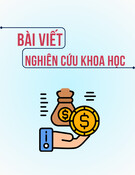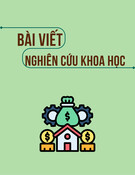
CHAPTER 24
Valuing Debt
Answers to Practice Questions
1. Some reasons Fisher’s theory might not be true are:
a. Taxes are levied on nominal interest. Therefore, if expected inflation is
high, part of the tax is actually on the real principal.
b. Inflation may be associated with the level of real economic activity, which,
in turn, may affect real interest rates.
c. It ignores uncertainty about inflation.
2. If expected real interest rates are negative, then individuals will be tempted to
save by buying and storing real goods. This forces the prices of goods up and
the prices of securities down until real rates are no longer negative.
However, goods are costly to store and expensive to resell if you do not want
them. Some goods are impossible to store, e.g., haircuts and appendectomies.
Prices of these goods may be expected to rise faster than the interest rate. Note
also that it is difficult for a country on its own to maintain a very low real rate
without imposing exchange controls on its citizens.
3. The key here is to find a combination of these two bonds (i.e., a portfolio of
bonds) that has a cash flow only at t = 6. Then, knowing the price of the portfolio
and the cash flow at t = 6, we can calculate the 6-year spot rate.
We begin by specifying the cash flows of each bond and using these and their
yields to calculate their current prices:
Investment Yield C1. . . C5C6Price
6% bond 12% 60 . . . 60 1,060 $753.32
10% bond 8% 100 . . . 100 1,100 $1,092.46
From the cash flows in years one through five, it is clear that the required
portfolio consists of one 6% bond minus 60% of one 10% bond, i.e., we should
buy the equivalent of one 6% bond and sell the equivalent of 60% of one 10%
bond. This portfolio costs:
$753.32 – (0.6 × $1,092.46) = $97.84
The cash flow for this portfolio is equal to zero for years one through five and, for
year 6, is equal to:
$1,060 – (0.6 × 1,100) = $400
Thus:
$97.84 × (1 + r6)6 = 400
r6 = 0.265 = 26.5%
220

4. Downward sloping. This is because high coupon bonds provide a greater
proportion of their cash flows in the early years. In essence, a high coupon bond
is a ‘shorter’ bond than a low coupon bond of the same maturity.
5. Using the general relationship between spot and forward rates, we have:
(1 + r2)2= (1 + r1) × (1 + f2) = (1.060) × (1.064) ⇒r2 = 0.062 = 6.2%
(1 + r3)3= (1 + r2)2 × (1 + f3) = (1.062)2 × (1.071) ⇒r3 = 0.065 = 6.5%
(1 + r4)4= (1 + r3)3 × (1 + f4) = (1.065)3 × (1.073) ⇒r4 = 0.067 = 6.7%
(1 + r5)5= (1 + r4)4 × (1 + f5) = (1.067)4 × (1.082) ⇒r5 = 0.070 = 7.0%
If the expectations hypothesis holds, we can infer—from the fact that the forward
rates are increasing—that spot interest rates are expected to increase in the
future.
6. In order to lock in the currently existing forward rate for year five (f5), the firm
should:
Borrow the present value of $100 million. Because this money will be
received in four years, this borrowing is at the four-year spot rate:
r4 = 6.7%
Invest this amount for five years, at the five-year spot rate: r5 = 7.0%
Thus, the cash flows are:
Today: Borrow (100/1.067)4 = $77.151 million
Invest $77.151 million for 5 years at 7.0%
Net cash flow: Zero
In four years: Repay loan: ($77.151 × 1.0674) = $100 million dollars
Net cash flow: -$100 million
In five years: Receive amount of investment:
($77.151 × 1.0705) = $108.2 million
Net cash flow: +$108.2 million
Note that the cash flows from this strategy are exactly what one would expect
from signing a contract today to invest $100 million in four years, for a time
period of one year, at today’s forward rate for year 5 (8.2%). With $108.2 million
available, the firm can cover the payment of $107 million at t = 5.
221

7. We make use of the usual definition of the internal rate of return to calculate the
yield to maturity for each bond.
5% Coupon Bond:
r = 0.06930 = 6.930%
7% Coupon Bond:
r = 0.06925 = 6.925%
12% Coupon Bond:
r = 0.06910 = 6.910%
Assuming that the default risk is the same for each bond, one might be tempted
to conclude that the bond with the highest yield is the best investment. However,
we know that the yield curve is rising (the spot rates are those found in
Question 5) and that, because the bonds have different coupon rates, their
durations are different.
5% Coupon Bond:
7% Coupon Bond:
222
0
r)(1
1050
r)(1
50
r)(1
50
r)(1
50
r)(1
50
920.70NPV 5432 =
+
+
+
+
+
+
+
+
+
+−=
0
r)(1
1070
r)(1
70
r)(1
70
r)(1
70
r)(1
70
1003.10NPV 5432 =
+
+
+
+
+
+
+
+
+
+−=
0
r)(1
1120
r)(1
120
r)(1
120
r)(1
120
r)(1
120
1209.20NPV 5432 =
+
+
+
+
+
+
+
+
+
+−=
920.70
1.070
(1050)5
1.067
(50)4
1.065
(50)3
1.062
(50)2
1.060
(50)1
DUR 5432 ++++
=
years4.52920.70/4157.5DUR ==
1003.10
1.070
(1070)5
1.067
(70)4
1.065
(70)3
1.062
(70)2
1.060
(70)1
DUR 5432 ++++
=
years4.381003.10/4394.5DUR ==

12% Coupon Bond:
Thus, the bond with the longest duration is also the bond with the highest yield to
maturity. This is precisely what is expected, given that the yield curve is rising.
We conclude that the bonds are equally attractive.
8. a. & b.
Year Discount Factor Forward Rate
1 1/1.05 = 0.952
2 1/(1.054)2 = 0.900 (1.0542 /1.05) – 1 = 0.058 = 5.8%
3 1/(1.057)3 = 0.847 (1.0573 /1.0542 ) – 1 = 0.063 = 6.3%
4 1/(1.059)4 = 0.795 (1.0594 /1.0573 ) – 1 = 0.065 = 6.5%
5 1/(1.060)5 = 0.747 (1.0605 /1.0594 ) – 1 = 0.064 = 6.4%
c. 1. 5%, two-year note:
$992.79
(1.054)
1050
1.05
50
PV 2=+=
2. 5%, five-year note:
$959.34
(1.060)
1050
(1.059)
50
(1.057)
50
(1.054)
50
1.05
50
PV 5432 =++++=
3. 10%, five-year note:
$1,171.43
(1.060)
1100
(1.059)
100
(1.057)
100
(1.054)
100
1.05
100
PV 5432 =++++=
d. First, we calculate the yield for each of the two bonds. For the 5% bond,
this means solving for r in the following equation:
5432 r)(1
1050
r)(1
50
r)(1
50
r)(1
50
r1
50
959.34 +
+
+
+
+
+
+
+
+
=
r = 0.05964 = 5.964%
For the 10% bond:
5432 r)(1
1100
r)(1
100
r)(1
100
r)(1
100
r1
100
1171.43 +
+
+
+
+
+
+
+
+
=
r = 0.05937 = 5.937%
223
1209.20
1.070
(1120)5
1.067
(120)4
1.065
(120)3
1.062
(120)2
1.060
(120)1
DUR 5432 ++++
=
years4.121209.20/4987.1DUR ==

The yield depends upon both the coupon payment and the spot rate at the
time of the coupon payment. The 10% bond has a slightly greater
proportion of its total payments coming earlier, when interest rates are
low, than does the 5% bond. Thus, the yield of the 10% bond is slightly
lower.
e. The yield to maturity on a five-year zero coupon bond is the five-year spot
rate, here 6.00%.
f. First, we find the price of the five-year annuity, assuming that the annual
payment is $1:
Now we find the yield to maturity for this annuity:
r = 0.0575 = 5.75%
g. The yield on the five-year Treasury note lies between the yield on a five-
year zero-coupon bond and the yield on a 5-year annuity because the
cash flows of the Treasury bond lie between the cash flows of these other
two financial instruments. That is, the annuity has fixed, equal payments,
the zero-coupon bond has one payment at the end, and the bond’s
payments are a combination of these.
9. A 6-year spot rate of 4.8 percent implies a negative forward rate:
(1.0486/1.065) - 1 = -0.01 = -1.0%
To make money, you could borrow $1,000 for 6 years at 4.8 percent and lend
$990 for 5 years at 6 percent. The future value of the amount borrowed is:
FV6 = $1,000 × (1.048)6 = $1,324.85
The future value of the amount loaned is:
FV5 = $990 × (1.06)5 = $1,324.84
This ensures enough money to repay the loan by holding cash over from year 5
to year 6, and provides an immediate $10 inflow.
The minimum sensible rate satisfies the condition that the forward rate is 0%:
(1 + r6)6/(1.06)5 = 1.00
This implies that r6 = 4.976 percent.
224
$4.2417
(1.060)
1
.059)(1
1
.057)(1
1
.054)(1
1
1.05
1
PV 5432 =++++=
5432 r)(1
1
r)(1
1
r)(1
1
r)(1
1
r1
1
4.2417 +
+
+
+
+
+
+
+
+
=


























